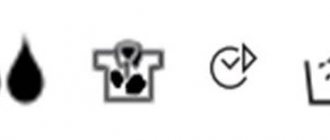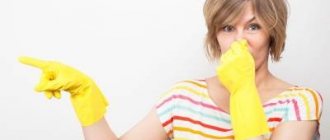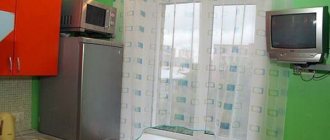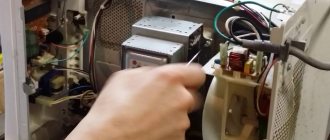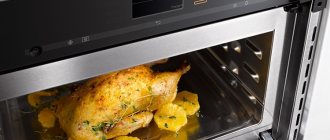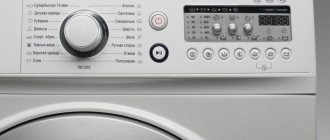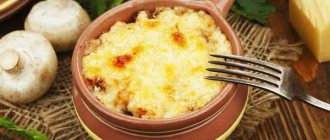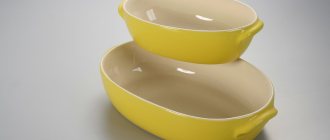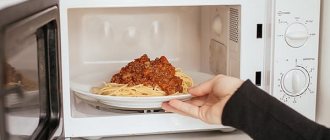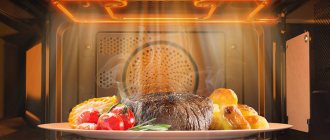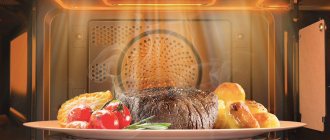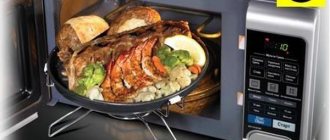It is difficult to imagine life without the convenience that a microwave oven provides. Take at least heating up any dish in a couple of minutes. More experienced users have mastered cooking and are also satisfied. Baking, boiling, heating, stewing or steaming, grilling, defrosting - it is very difficult to list all the possibilities that this reliable assistant provides.
There are very few restrictions when using a microwave oven. The main one concerns the material from which the container that can be irradiated can be made. Sometimes a microwave icon on a dish can serve as a clue, and if there isn’t one, how do you know if it can be used? After all, using the wrong material will damage the equipment or adversely affect people’s health.
Protective plastic cover to protect against splashes and moisture loss
What dishes can be used in the microwave?
Examples of labeling for microwave ovens
The general prohibition for everything that is prohibited for a microwave oven is “No metal!” Metal or metallized coating, reinforcing mesh, handles, funnels, prints or micro-inclusions of metal will cause sparks to jump inside the chamber, the magnetron will start to spark, and the equipment will fail.
The following types of containers are suitable for all microwave oven modes:
Types of dishes for microwave ovens
- Glass. Almost all types of glass trays, pans, salad bowls or heat-resistant glass forms are suitable for any microwave oven mode. Thin-walled glass is suitable only for short-term heating of liquid. They transmit radiation, food looks aesthetically pleasing, you can monitor the cooking process, it’s easy to care for, plus it’s durable (if you don’t throw it or put it hot on a cold table). Manufacturers of household appliances recommend using round or oval glassware; heating plus cooking proceeds faster and more evenly.
- Silicone. Silicone products for the kitchen, which are quickly conquering the market, have reached microwave ovens. Now on the market you can find a huge range of baking dishes made of multi-colored food grade silicone. It allows you to cook without oil, it is easy to clean, it is not afraid of the dishwasher or high temperatures, it has a non-stick property and is quite durable. It is important to buy products from trusted manufacturers, only food grade silicone.
Sample of silicone product
Plastic. Trays, containers, pallets or cups made of polymers are often used by housewives. But a microwave oven requires special plastic - heat-resistant plus suitable for microwave exposure. Otherwise, the output will be a deformed piece of plastic. There are types of plastic that can only be heated in, that is, exposed to heat for a short time, but cooking, especially with fat, is not recommended. You can find out which type of polymer is suitable for a microwave oven by the markings on the walls or bottom.
Reception of plastic containers
- Clay. This includes ceramic, earthenware, porcelain or earthenware dishes - any that contain clay, without inclusions or metal decoration. Food heats up and cooks a little worse in it, since it does not transmit microwaves well. First, the walls warm up, and only then does the food, so you need to follow all safety rules when removing it from the oven. You need to carefully ensure that there are no cracks on the surface - due to the temperature difference, such a cracked cup or plate will simply burst during heating.
- Paper. Food packaged in paper bags, envelopes, plus plastic or film - all this is suitable for use in the microwave only for heating, but not for long, a couple of minutes. Otherwise, the film will begin to melt or even catch fire.
Food in packaging that can be heated in a microwave oven
- Fabric. It is convenient to heat flour and bakery products in linen or cotton napkins.
Containers that can be used in microwave ovens have special markings that allow you to understand their purpose.
Samples of symbols on dishes
Plastic that can be used in microwave ovens
Plastic marking
If it can be frozen or exposed to low temperatures, then there will be an image of snowflakes. The more snowflakes, the lower the temperature the material can withstand.
Marking on plastic
Plastic, its types and designations
If plastic products have a triangle of arrows with the number 6 inside and the abbreviation PS, this means that the polymer is polystyrene, which means it cannot be heated, poured hot, or used in a microwave oven!
If the designation is the number 5 plus PP, then this is the mass of polypropylene. Such containers can be used in a microwave oven, but without the use of alcohol, which as a result of a chemical reaction will release formaldehyde and phenol, which, if ingested, can lead to blindness.
The pictogram on the plastic in the form of a glass and fork means that the product tolerates high temperatures well and is intended for food products. It allows you to heat or hold food products. If such a sign is crossed out, then this indicates the opposite - non-food plastic.
Special dishes for a microwave oven have a symbol on them in the form of a microwave oven and a plate inside it.
All other types of plastics release toxic substances when heated and can be hazardous to health, especially if they are exposed to heat or microwaves.
Signs indicating operating rules
Cooking rules are important, but it is equally important to know how to care for your cookware. This will help preserve its original appearance and quality of the material. For this, there are a number of markings that should also be studied.
- There are dishes drawn in the square. This icon says that it can be washed in a dishwasher, because this unit has long been installed in every second apartment. If the icon has a red diagonal stripe, then washing in the dishwasher is strictly prohibited.
- There is a thermometer in the square and a plate next to it . Such a symbol can be indicated on glassware and it indicates that the material of the set can withstand temperature changes.
- Presence of a snowflake . This symbol indicates that the dishes can be used in the refrigerator. And if there are three snowflakes, then even in the freezer. This dish is good for freezing semi-finished and ready-made foods.
These are the main markings that are indicated on pots and pans.
The presence of certain symbols depends on the material.
After all, not every metal utensil can be used in the dishwasher. And not every plastic is suitable for freezing.
But the most important factor is the presence of a “glass-fork” icon, which indicates that the glassware is absolutely safe for food. Also often such a sign is indicated on glassware and symbolizes the fragility of the material.
Many people take the “glass and fork” icon as permission to use the glassware in the microwave oven. However, it is not. For microwaves, different markings are used.
Ban theme or metal utensils
You need to be very careful that no knife or fork gets into the microwave, that there is no pattern on the plates with metal additives, otherwise an electric charge will accumulate, then the oven will fail - the magnetron will deteriorate, without which there will be no microwave waves, and the replacement of which costs half the cost device.
Prohibited utensils for microwave oven:
- Any types of metal utensils. All metals do not allow microwaves to pass through, they accumulate an electric charge, that is, the food does not heat up, but the metal walls heat up, sparks occur, and the equipment fails.
- Containers made of any material with designs using paints that include metal. This is clearly noticeable when it heats up and sparks. It’s tedious to immediately turn off the stove and take out the metal threat.
- Natural crystal. Uneven walls and inclusions of metal microparticles will lead to the fact that under the influence of microwaves, crystal products turn into small fragments.
- Dishes made of foil. It would seem that everyone understands that metal foil is strictly forbidden to be used in microwave ovens, but people mistakenly heat grilled chicken in foil, breakfast or semi-finished products, baked foods, which causes irreversible damage to the magnetron.
- Waxed paper containers, packaging. Semi-finished products, various ready-made industrially produced dishes, all of this can be heated if the packaging contains such recommendations from the manufacturer, but only once.
- Pottery without glaze. Thick clay walls heat up unevenly and may crack in the microwave. And they also keep the food cold, even if the plate itself is too hot to touch.
- Thin-walled glass. Such products cannot withstand heat and most often burst when heated for too long.
- Containers of any type with microcracks. When the container plus its contents heats up, uneven expansion occurs, so most likely the item that bursts will break into pieces.
- Wooden crafts. Usually they either dry out or are charred in microwave ovens.
- Plastic, film. It is permissible to use only those types of polymer materials that have the appropriate markings, otherwise the products will become deformed or will release toxic substances into the food. Of the huge amount of food and non-food plastic, only polypropylene can be irradiated with microwaves without harm to health; it is also marked with the number 5 or PP.
Decoding markers
The most common symbol on plastic utensils is a triangle in the shape of three arrows. Near or below these arrows there are inscriptions or numbers indicating a specific marker. Ignorance of what these arrows or inscriptions mean leads to the fact that users purchase goods containing food products that are in containers made of non-food grade plastic. Although not all of the plastics described below are recommended for use in food storage, seven different labels may be found on food packaging. Their classification is presented in the table below.
| Icon inside a triangle | What does the inscription mean? |
| 5 | Safe. Used for the production of reusable food containers. Together with plastic number two, they are considered the most approved. Near the icon there is the inscription PP (PP) |
| 2 | Safe. Cleared for reuse. Has high density. Near the icon there is the inscription HDPE (LDPE) |
| 1 | Cheap material. Used in the production of mineral water containers. When reused, this material releases toxic substances. Near the icon is the inscription PET (PET) |
| 4 | Considered to be approved plastic. Can be reused. Used for the manufacture of packaging materials and bags. Near the icon there is the inscription LDPE (HDPE) |
| 3 | When burned, it releases very dangerous substances. Capable of releasing toxins and chemical compounds, especially when heated. Near the icon is the inscription PCV (PVC) |
| 6 | In addition to food containers, foam is made from this plastic. Caps for disposable cups are made from it. Next to the icon is the inscription PS (PS) |
| 7 | The most unsafe group. It includes all types of plastic that are not included in the previous six groups. Some of them may even be toxic and poisonous. Plastics of this group could not be classified into any of the above, which means they are the most dangerous. Their dangerous properties increase when in contact with hot water, food or when heated. Near the icon there is the inscription OTHER |
As the information described above shows, the most approved types of plastic are those that have numbers two and five. All types of plastic containers marked with number 7 are strictly not recommended. The harmful substances released can be harmful to health.
Tips for choosing microwave cookware
In order for the purchased utensils to be suitable for any microwave cooking modes, it is better to immediately take a universal one or not get confused when choosing such modes as convection, grill or combined when there is exposure to high temperatures.
Tips for choosing cookware:
- It is better to take heat-resistant products (it should withstand more than 220°C, optimally up to 300°C).
- The walls of the products must transmit microwaves without interference - that is, not be too thick, not have any inclusions or coating with metal.
- It must be intact; air bubbles inside the material or defects are also not allowed.
- Heating test - the selected container is filled with water, heated for a minute until it boils. The ideal dish will be moderately hot with boiled nutria water.
A microwave oven opens up endless possibilities for an imaginative housewife. Many modes, a programming function, and at the finish - almost any dish with the preservation of nutrients in a minimum time.
